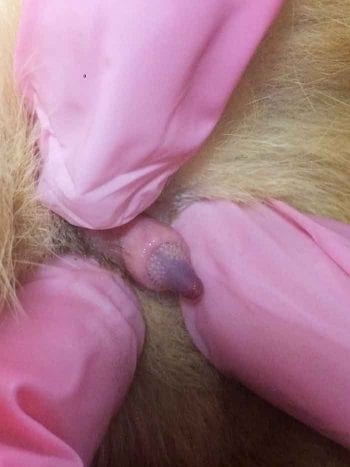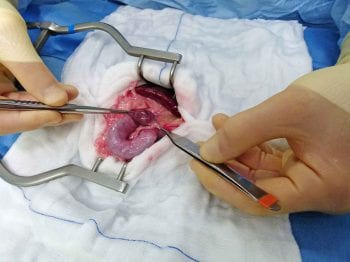17 Jun 2019
Fiona Adam and Marco Armellini present history, physical examination and ultrasound findings to help diagnose a cat's behavioural problem.

Figure 4. Resection of the intra-abdominal testicle. Image: Benito de la Puerta
A five-year-old male neutered British shorthair cat presented with a progressive six-month history of urine spraying outdoors and indoors, inter-cat aggression to both household and neighbourhood cats, and dominant behaviour over food.
The cat resided in a multi-cat household, which had traditionally been a breeding household. The owners had ceased breeding cats several years before, and all six cats in the household were neutered at the point of presentation.

Urine spraying is normal cat behaviour, thought to be related to territory marking. The incidence is much higher in entire animals. Increased expression of this behaviour, especially starting to spray indoors, can be due to a primary behavioural motivation (most typically a response to a stressor), or due to disease such as orthopaedic pain or lower urinary tract disease. The inter-cat aggression and food-related dominance may also be primary behavioural issues, or relate to underlying disease (endocrinopathies, pain, brain disease and so on).
The spraying behaviour, in conjunction with the increased aggression and food-related dominance, may be characteristics seen in male entire animals, thus testosterone exposure (either endogenous or exogenous) should be considered for this cat. The cat was neutered at six months of age; both testicles had been confirmed to be present in the scrotum, and the castration was reported to have been completed uneventfully. No history of exogenous testosterone administration/exposure existed.
Testosterone presence generates phenotypic features in male entire cats, including large head, more muscled appearance and “stud tail” (supracaudal gland hyperplasia), which can support suspicions of intact status, but these features are subjective, and not pathognomonic of male entire status. A much more robust finding, seen in male entire cats, is the presence of barbs on the penis.
The biological function of the penile barbs of the male entire cat is thought to be stimulation of induced ovulation in the queen at mating. The barbs begin to develop at around 12 weeks of age, and are fully developed by six months of age, and their presence depends on testosterone. At neutering, the spines begin to regress by two weeks postoperatively, and are fully regressed within six to eight weeks.
The cat was bright and in good body condition. He had a large head and relatively marked muscling. No testicles were palpable in the scrotum, and the scrotum was small – consistent with the history of neutering at a young age. Penile examination confirmed the presence of barbs (Figure 1).
The presence of barbs on this neutered cat’s penis is highly atypical and very strongly supports the presence of testosterone – a potential explanation for the presenting complaints.
Confirmation of testosterone excess could be achieved by testosterone assay. A single measurement, if high, is confirmatory, but given the potential fluctuations in blood concentrations, and the lower testosterone levels of immature animals, low levels should be further investigated with a human chorionic gonadotropin stimulation test (unlicensed for use in cats) where suspicions for elevated testosterone levels are present.
Anti-Müllerian hormone would also be expected to be high in cats with testicular tissue present, so would be another diagnostic option to investigate neuter status (Axnér and Ström Holst, 2015).
Potential sources of testosterone:

This cat, with barbed penis, and comprehensive neutering history, was thus imaged by abdominal ultrasound to further investigate for a potential adrenal mass. Abdominal ultrasound showed both adrenal glands to be normal in size and shape (Figure 2). However, a 15mm x 10mm vascularised, ovoid soft-tissue mass was located in the caudal peritoneal cavity, adjacent to the descending colon (Figure 3). The anatomy and vascular pattern were strongly suggestive of an intra-abdominal testicle. Cytology confirmed the mass as a testicle, with no evidence of testicular pathology, such as neoplasia.
Given the robust neutering history of this cat, the testicle is presumed to be supranumerary. Two reports exist of cats with supranumerary testicles in the literature (Milwright and Smith, 1999; Roca-Ferrer et al, 2015). It is a very rare congenital anomaly, reported in humans and veterinary species. The mechanism for developed polyorchidism is unclear, but is thought to relate to abnormal migration during the duplication or division of the genital ridge in embryogenesis.
Exploratory coeliotomy to enable the resection of the intra-abdominal testicle was performed (Figure 4). Removal of the testicle would be expected to address the testosterone-associated behavioural problems, and eradicate the risk of development of testicular neoplasia, which is a common problem of intra-abdominal testes.